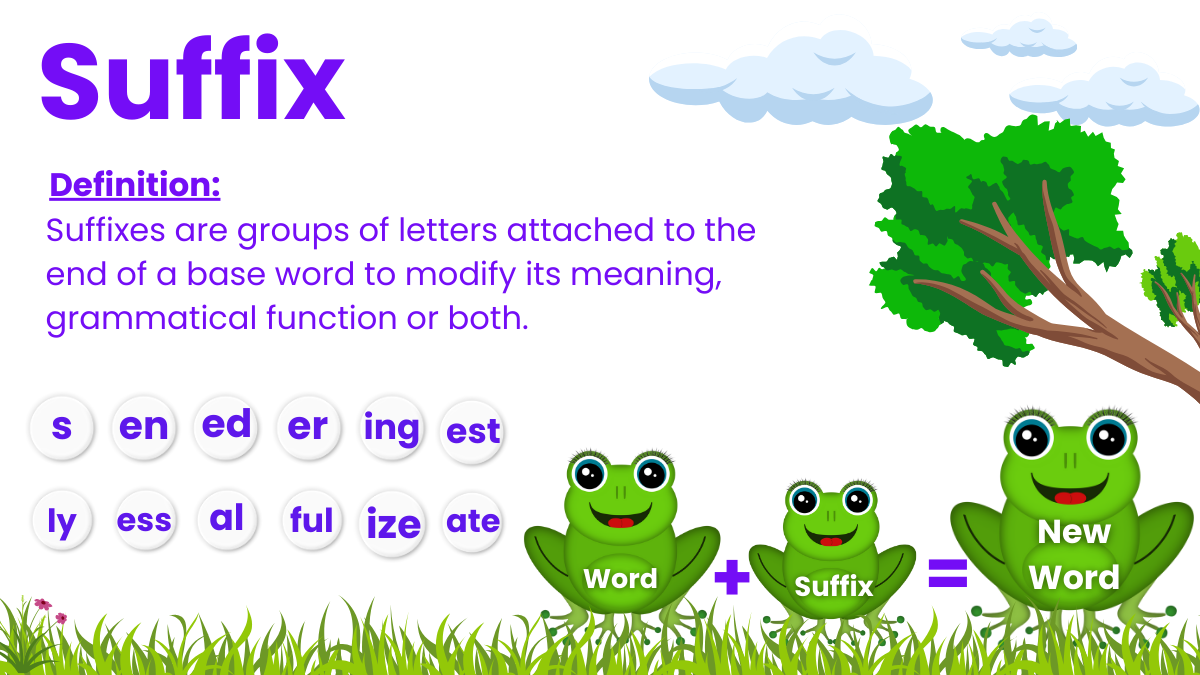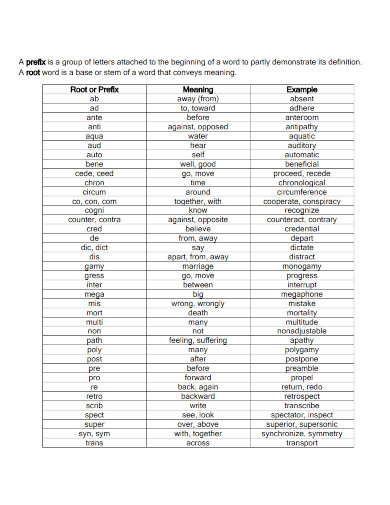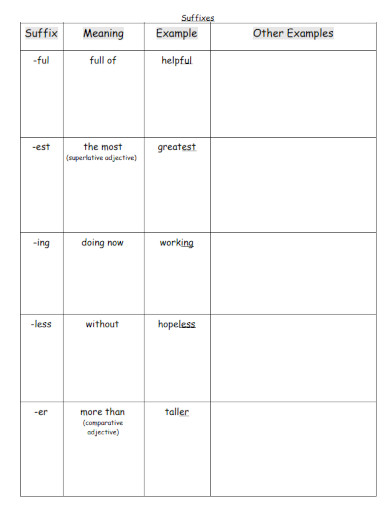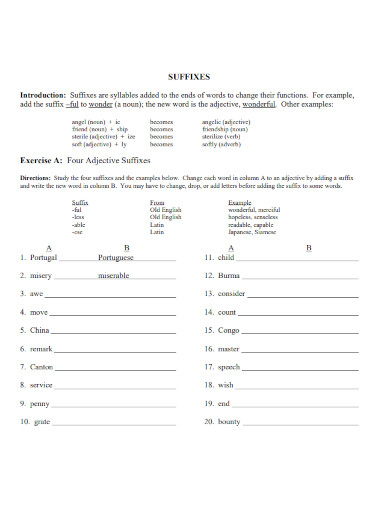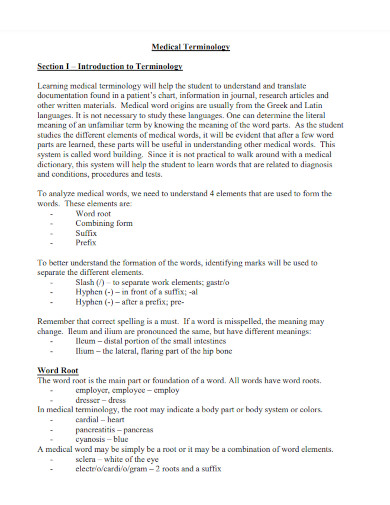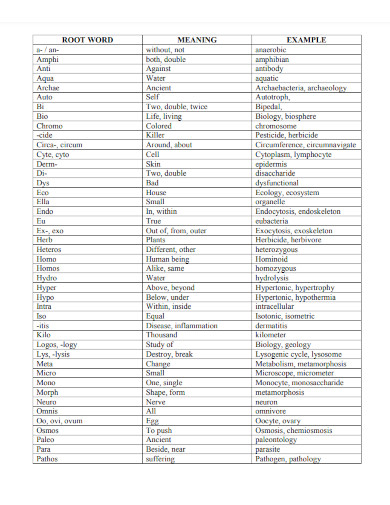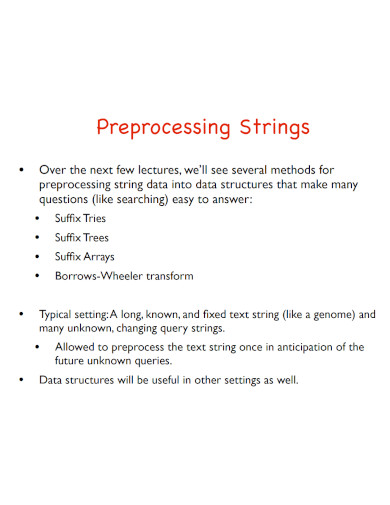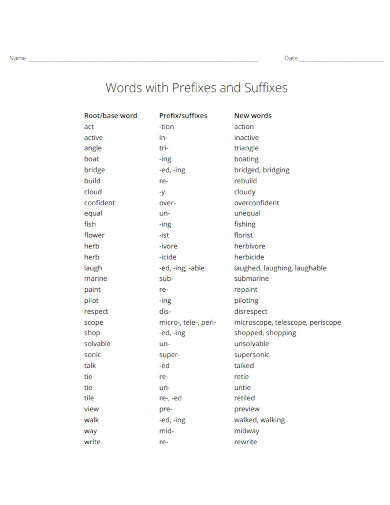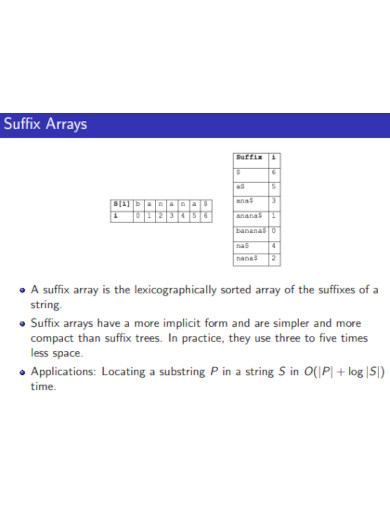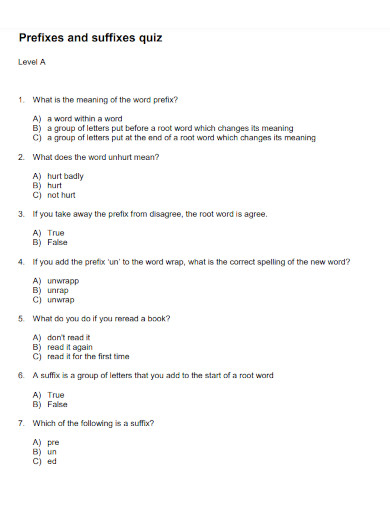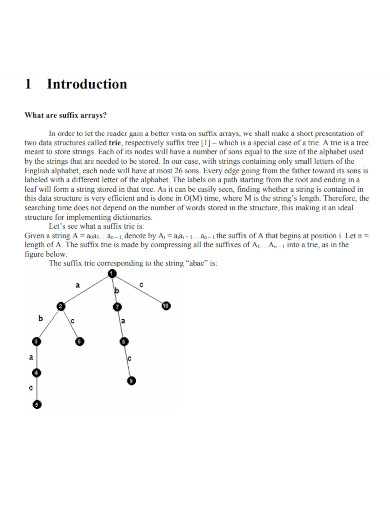200+ Suffix Examples
Writers can improve their books, qualitative and quantitative research, and journal articles through the use of various techniques and literary devices. When writing using the English language, one will need to understand how to use suffixes as a modifier.
In the realm of linguistics, suffixes play a crucial role in shaping the meaning and function of words. This article explores the diverse types and impacts of suffixes in various languages, illuminating their significance in grammatical structures and word formation
What is suffix?
Suffixes are groups of letters attached to the end of a base word to modify its meaning, grammatical function, or both. They can alter a word’s tense, form a different part of speech, or change its number from singular to plural.
Inflectional vs. derivational suffixes
| Feature | Inflectional Suffixes | Derivational Suffixes |
|---|---|---|
| Purpose | Modify a verb, noun, adjective, or adverb to express grammatical features such as tense, case, voice, aspect, person, number, gender, and mood. | Change the meaning of a word or its part of speech, creating a new word entirely. |
| Effect on Part of Speech | Do not change the part of speech of the word to which they are added. | Often change the part of speech or the basic meaning of the word. |
| Examples | – Verbs: talk -> talks, talked, talking | – happy -> happiness (noun) |
| – Nouns: dog -> dogs | – real -> realize (verb) | |
| – Adjectives: fast -> faster, fastest | – child -> childish (adjective) | |
| – Adverbs: early -> earlier, earliest | – care -> careful (adjective) | |
| Number of Common Suffixes | Very few (about 8 in English) | Numerous, with a wide variety allowing for a great variety of changes. |
| Productivity | Highly productive; used regularly and widely across many words. | Less productive; not all derivational suffixes are equally usable with all roots. |
| Examples of Suffixes | – -s, -es (pluralize nouns) | – -ness (forms nouns) |
| – -ed, -ing (verb tenses) | – -ize, -ify (forms verbs) | |
| – -er, -est (comparative and superlative adjectives) | – -ly (forms adverbs) |
Examples of suffixes in English: Inflectional
- -s, -es: Used to pluralize nouns (e.g., dog → dogs, box → boxes)
- -ed: Used to form the past tense of regular verbs (e.g., walk → walked)
- -ing: Used to form the present participle of verbs (e.g., run → running)
- -er: Used to form the comparative degree of adjectives and some adverbs (e.g., small → smaller)
- -est: Used to form the superlative degree of adjectives and some adverbs (e.g., fast → fastest)
- -en: Used to form the past participle of some irregular verbs (e.g., eat → eaten)
- -s, -es: Used to form the third person singular present tense of verbs (e.g., he runs, she watches)
Examples of suffixes in English: Derivational
- -ness: Turns adjectives into nouns, indicating a state or quality (e.g., “happiness” from “happy”).
- -ly: Converts adjectives into adverbs, describing how an action is performed (e.g., “quickly” from “quick”).
- -er: Forms nouns often denoting people associated with an activity, or a comparative adjective (e.g., “baker” from “bake”, “faster” from “fast”).
- -ment: Transforms verbs into nouns, indicating the action or result of a verb (e.g., “payment” from “pay”).
- -ation: Turns verbs into nouns, often to denote the action or process of the verb (e.g., “information” from “inform”).
- -able/-ible: Makes verbs into adjectives, suggesting something can be done (e.g., “readable” from “read”).
- -ive: Forms adjectives that imply an attribute or quality (e.g., “creative” from “create”).
- -ous: Turns nouns into adjectives, indicating possession or presence of a quality (e.g., “dangerous” from “danger”).
- -ity: Converts adjectives into nouns, denoting the state or condition of (e.g., “reality” from “real”).
- -ize/-ise: Turns nouns and adjectives into verbs, meaning to make or to become (e.g., “realize” from “real”).
Examples of Suffix in Sentences
-ly (adverb form)
- Quickly: She quickly ran to catch the bus.
- Happily: They happily shared their picnic with the newcomers.
- Softly: The mother softly sang a lullaby to her baby.
- Loudly: The students loudly cheered for their team at the game.
- Easily: She easily solved the math problem.
-ness (state or quality)
- Kindness: His kindness to animals is well-known in the neighborhood.
- Darkness: The darkness of the cave made it difficult to see.
- Weakness: His weakness for sweets led him to overeat.
- Happiness: Her happiness was evident in her smile.
- Sadness: The movie’s ending filled her with sadness.
-ment (action or process)
- Enjoyment: His enjoyment of the concert was clear from his enthusiastic applause.
- Achievement: Completing the marathon was a significant achievement for her.
- Development: The rapid development of the town attracted many new residents.
- Movement: The movement of the train rocked the passengers gently.
- Commitment: Their commitment to the project ensured its success.
-able (capable of)
- Comfortable: The new sofa is incredibly comfortable.
- Portable: The speaker is small and portable, perfect for travel.
- Breakable: These glasses are very delicate and breakable.
- Readable: His handwriting is clear and easily readable.
- Reliable: She is known for being a reliable friend.
-er (one who)
- Teacher: The teacher assigned homework to be completed by Monday.
- Writer: The writer published his first novel last year.
- Runner: The runner trained every day for the marathon.
- Painter: The painter captured the beauty of the landscape on canvas.
- Singer: The singer performed a new song at the concert.
-ing (present participle)
- Running: Running every morning has improved his health.
- Reading: She was reading a fascinating book about ancient history.
- Singing: The group was singing in perfect harmony.
- Dancing: They were dancing joyfully at the festival.
- Cooking: He was cooking dinner when the phone rang.
-ed (past tense)
- Walked: They walked along the beach at sunset.
- Jumped: The dog jumped over the fence to chase the ball.
- Painted: She painted the walls a bright blue color.
- Played: They played soccer in the park all afternoon.
- Smiled: He smiled when he saw his friend across the room.
-ful (full of)
- Joyful: The joyful children played in the park all day.
- Hopeful: She felt hopeful about her chances of getting the job.
- Colorful: The artist’s paintings are always very colorful.
- Peaceful: They enjoyed a peaceful afternoon by the lake.
- Thoughtful: His thoughtful gesture made her day.
-less (without)
- Homeless: The shelter provides food and warmth for homeless people.
- Fearless: The fearless firefighter rescued the family from the burning house.
- Endless: They faced an endless series of challenges on their journey.
- Careless: His careless mistake cost the team the game.
- Worthless: The old, broken watch was completely worthless.
-tion (action or result)
- Celebration: The celebration lasted well into the night.
- Education: Education is the key to a brighter future.
- Organization: The organization of the event was impressive.
- Communication: Good communication is essential in a relationship.
- Transformation: The transformation of the garden was remarkable.
-ish (having the quality of)
- Childish: His childish antics made everyone laugh.
- Foolish: It was foolish to go out without an umbrella in the rain.
- Stylish: She always wears the most stylish clothes.
- Reddish: The sunset cast a reddish glow over the horizon.
- Selfish: His selfish behavior alienated his friends.
Examples of Suffix in Medical Terminology
-itis (inflammation)
- Appendicitis: Appendicitis is a medical emergency that requires prompt surgery.
- Bronchitis: The doctor diagnosed her with bronchitis after she complained of a persistent cough.
- Arthritis: Arthritis can cause severe joint pain and stiffness.
- Dermatitis: The patient was treated for dermatitis with a topical cream.
- Tonsillitis: Tonsillitis often causes sore throat and swollen tonsils.
-ectomy (surgical removal)
- Appendectomy: She had an appendectomy to remove her inflamed appendix.
- Mastectomy: A mastectomy is a common treatment for breast cancer.
- Tonsillectomy: Children frequently undergo tonsillectomy to prevent recurrent throat infections.
- Cholecystectomy: A cholecystectomy is the removal of the gallbladder.
- Hysterectomy: A hysterectomy may be necessary for various gynecological conditions.
-ology (study of)
- Cardiology: Cardiology is the study of heart diseases.
- Neurology: Neurology focuses on disorders of the nervous system.
- Dermatology: Dermatology deals with skin conditions and diseases.
- Oncology: Oncology is the study and treatment of cancer.
- Psychology: Psychology explores the mind and behavior.
-oma (tumor)
- Carcinoma: Carcinoma is a type of cancer that begins in the skin or tissues lining organs.
- Sarcoma: Sarcoma is a malignant tumor that arises from connective tissues.
- Lymphoma: Lymphoma affects the lymphatic system and can be either Hodgkin’s or non-Hodgkin’s.
- Melanoma: Melanoma is a serious form of skin cancer that develops from pigment-producing cells.
- Adenoma: Adenoma is a benign tumor of glandular tissue.
-pathy (disease)
- Neuropathy: Neuropathy often results in numbness and pain, especially in the hands and feet.
- Cardiomyopathy: Cardiomyopathy is a disease of the heart muscle.
- Nephropathy: Diabetic nephropathy is a common complication of diabetes affecting the kidneys.
- Myopathy: Myopathy refers to diseases affecting muscle tissue.
- Retinopathy: Diabetic retinopathy can lead to blindness if not treated.
-stomy (creating an opening)
- Colostomy: A colostomy involves creating an opening from the colon to the surface of the abdomen.
- Tracheostomy: A tracheostomy is performed to create an airway in patients who cannot breathe normally.
- Gastrostomy: A gastrostomy provides a means of feeding directly into the stomach.
- Urostomy: A urostomy diverts urine away from the bladder to an opening in the abdomen.
- Jejunostomy: A jejunostomy tube is used for long-term feeding directly into the small intestine.
-scopy (visual examination)
- Endoscopy: An endoscopy allows doctors to view the inside of the digestive tract.
- Colonoscopy: A colonoscopy is used to examine the large intestine for polyps or cancer.
- Bronchoscopy: Bronchoscopy helps diagnose lung conditions by looking inside the airways.
- Laparoscopy: Laparoscopy is a minimally invasive procedure to view the organs inside the abdomen.
- Cystoscopy: A cystoscopy enables examination of the bladder and urethra.
-algia (pain)
- Neuralgia: Neuralgia causes intense, burning pain along a damaged nerve.
- Arthralgia: Arthralgia refers to joint pain, which can be a symptom of arthritis.
- Myalgia: Myalgia means muscle pain, often associated with overuse or injury.
- Fibromyalgia: Fibromyalgia is a chronic condition characterized by widespread pain and fatigue.
- Cephalalgia: Cephalalgia is the medical term for headache.
-genesis (origin or production)
- Pathogenesis: Pathogenesis is the study of how diseases develop.
- Carcinogenesis: Carcinogenesis refers to the process by which normal cells turn into cancer cells.
- Angiogenesis: Angiogenesis is the formation of new blood vessels.
- Osteogenesis: Osteogenesis is the process of bone formation.
- Neurogenesis: Neurogenesis is the production of new neurons in the brain.
-emia (blood condition)
- Anemia: Anemia is a condition characterized by a deficiency of red blood cells.
- Leukemia: Leukemia is a type of cancer that affects white blood cells.
- Hyperlipidemia: Hyperlipidemia refers to high levels of lipids in the blood.
- Septicemia: Septicemia, also known as blood poisoning, is a serious bloodstream infection.
- Hypoglycemia: Hypoglycemia occurs when blood sugar levels drop too low.
Examples of Suffix for Kids
-er (one who)
- Runner: She is the fastest runner in her class.
- Teacher: The teacher read a story to the students.
- Baker: The baker made a delicious cake.
- Painter: The painter created a beautiful mural.
- Reader: He is a great reader and loves books.
-ly (in the manner of)
- Quickly: She quickly finished her homework.
- Happily: They played happily in the park.
- Softly: The kitten meowed softly.
- Loudly: He laughed loudly at the funny joke.
- Slowly: The turtle moved slowly across the yard.
-ing (present participle)
- Running: The dog is running in the yard.
- Reading: She is reading a new book.
- Singing: They are singing their favorite song.
- Dancing: The children are dancing at the party.
- Drawing: He is drawing a picture of a house.
-ed (past tense)
- Jumped: The frog jumped into the pond.
- Played: They played a game of tag.
- Talked: She talked to her friend on the phone.
- Cooked: Dad cooked dinner for the family.
- Painted: They painted the fence white.
-ness (state or quality)
- Happiness: The puppy brings happiness to everyone.
- Kindness: Her kindness to others makes her special.
- Darkness: The darkness outside made it hard to see.
- Sadness: His sadness was clear when his balloon popped.
- Shyness: Her shyness made her quiet in new places.
-ful (full of)
- Joyful: The joyful child smiled all day.
- Helpful: He was very helpful when cleaning up.
- Colorful: The rainbow is very colorful.
- Peaceful: The lake is peaceful in the morning.
- Wonderful: They had a wonderful time at the zoo.
-less (without)
- Hopeless: The situation seemed hopeless, but they didn’t give up.
- Fearless: The fearless cat jumped from the tree.
- Endless: The endless sky is full of stars.
- Careless: His careless mistake spilled the milk.
- Sleepless: The sleepless night made him tired the next day.
-y (characterized by)
- Sunny: It was a sunny day at the beach.
- Windy: The windy weather blew the leaves around.
- Rainy: On a rainy day, they stayed inside.
- Snowy: The snowy hill was perfect for sledding.
- Cloudy: It was cloudy but still warm outside.
-ous (full of)
- Dangerous: The jungle can be a dangerous place.
- Curious: The curious kitten explored the house.
- Famous: He wants to be a famous singer one day.
- Nervous: She felt nervous before the big test.
- Joyous: The event was a joyous occasion for everyone.
-able (capable of)
- Lovable: The puppy is so lovable.
- Breakable: Be careful with the breakable vase.
- Comfortable: This chair is very comfortable.
- Adorable: The baby is simply adorable.
- Readable: The book has large, readable text.
Examples of Suffix for Names
– Jr. (Junior)
- John Smith Jr.: John Smith Jr. followed in his father’s footsteps and became a lawyer.
- Michael Johnson Jr.: Michael Johnson Jr. won the race, just like his dad used to.
- David Brown Jr.: David Brown Jr. enjoys playing baseball with his father.
- Robert Davis Jr.: Robert Davis Jr. graduated from the same college as his father.
- Thomas Miller Jr.: Thomas Miller Jr. is proud to carry his father’s name.
– Sr. (Senior)
- John Smith Sr.: John Smith Sr. retired after a long and successful career.
- Michael Johnson Sr.: Michael Johnson Sr. coached his son’s football team.
- David Brown Sr.: David Brown Sr. received an award for his community service.
- Robert Davis Sr.: Robert Davis Sr. enjoys spending time with his grandchildren.
- Thomas Miller Sr.: Thomas Miller Sr. started the family business many years ago.
– II (the Second)
- William Harris II: William Harris II continued the family tradition of military service.
- Henry Thompson II: Henry Thompson II inherited his grandfather’s watch.
- Charles Evans II: Charles Evans II opened a new branch of the family business.
- James White II: James White II is known for his excellent piano skills.
- George Martin II: George Martin II recently celebrated his 50th birthday.
– III (the Third)
- John Smith III: John Smith III is the third generation to attend Harvard University.
- Michael Johnson III: Michael Johnson III is an accomplished athlete like his father and grandfather.
- David Brown III: David Brown III joined the family law firm.
- Robert Davis III: Robert Davis III is interested in genealogy and family history.
- Thomas Miller III: Thomas Miller III is learning the trade from his father and grandfather.
– IV (the Fourth)
- John Smith IV: John Smith IV is proud to be the fourth in his family to carry the name.
- Michael Johnson IV: Michael Johnson IV is a talented musician like his ancestors.
- David Brown IV: David Brown IV just started college, following the family tradition.
- Robert Davis IV: Robert Davis IV enjoys sailing, a hobby passed down from his great-grandfather.
- Thomas Miller IV: Thomas Miller IV is studying engineering, continuing the family legacy.
– Esq. (Esquire)
- John Smith Esq.: John Smith Esq. is a well-respected lawyer in the community.
- Michael Johnson Esq.: Michael Johnson Esq. specializes in corporate law.
- David Brown Esq.: David Brown Esq. represented his clients in a high-profile case.
- Robert Davis Esq.: Robert Davis Esq. offers pro bono legal services.
- Thomas Miller Esq.: Thomas Miller Esq. has a reputation for his courtroom skills.
– M.D. (Doctor of Medicine)
- John Smith M.D.: John Smith M.D. is a renowned cardiologist.
- Michael Johnson M.D.: Michael Johnson M.D. works at the city’s largest hospital.
- David Brown M.D.: David Brown M.D. has been practicing medicine for over 20 years.
- Robert Davis M.D.: Robert Davis M.D. is known for his research in medical science.
- Thomas Miller M.D.: Thomas Miller M.D. specializes in pediatric care.
– Ph.D. (Doctor of Philosophy)
- John Smith Ph.D.: John Smith Ph.D. is a professor of English literature.
- Michael Johnson Ph.D.: Michael Johnson Ph.D. conducts research in the field of biology.
- David Brown Ph.D.: David Brown Ph.D. published a book on economic theory.
- Robert Davis Ph.D.: Robert Davis Ph.D. teaches history at the university.
- Thomas Miller Ph.D.: Thomas Miller Ph.D. is an expert in environmental science.
Suffix vs. Priffix
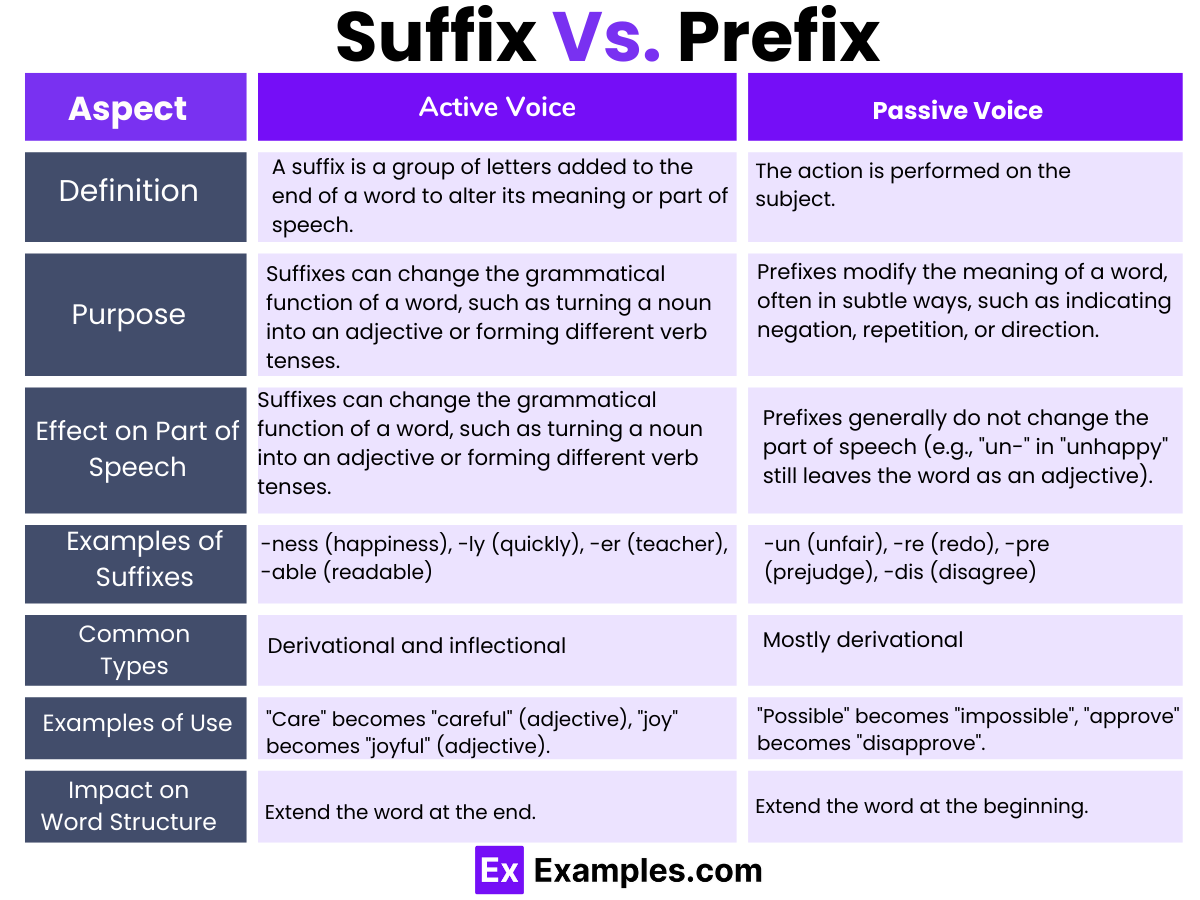
50+ Words examples using Suffix
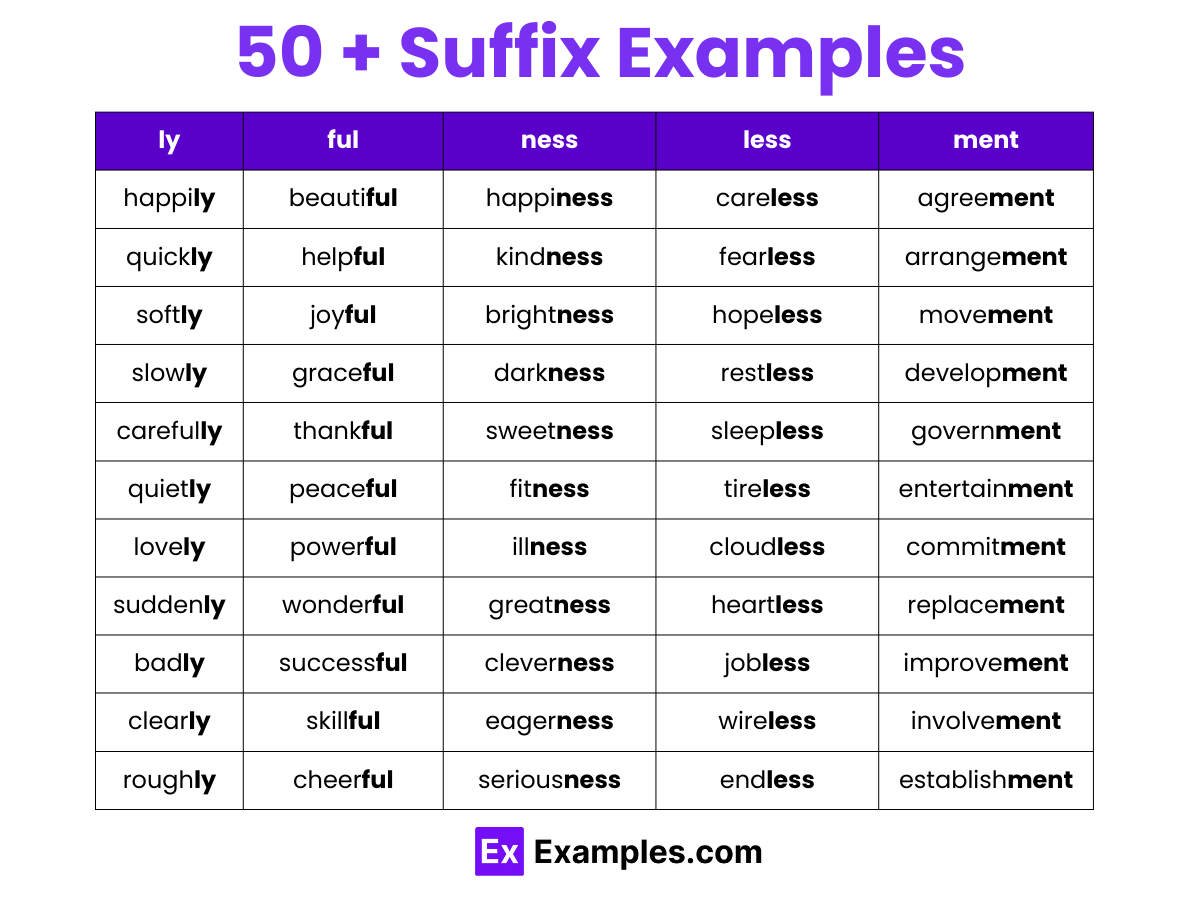
More Suffix Templates in PDF
1. Prefixes, Suffixes and Roots
2. Suffix Meaning Example
3. Suffix Exercise
4. Suffix Medical Terminology
5. Biology Root Words & Suffixes
6. Suffix Trees
7. Words with Prefixes and Suffixes
8. Linear Work Suffix Array Construction
9. Prefixes and Suffixes Quiz
10. Suffix Arrays
Importance of Suffixes in a Sentence
Suffixes play a crucial role in English sentences by impacting the meaning and grammatical structure of words. Here’s why they are important:
-
Changes in Meaning: Suffixes can profoundly alter the meaning of the base word. For example, adding -less to “hope” creates “hopeless,” indicating a complete lack of hope, while -ful added to “joy” forms “joyful,” implying full of joy.
-
Formation of New Words: Suffixes are key in expanding the English vocabulary. By adding suffixes like -ment, -ation, or -ity to verbs, new nouns are formed (e.g., “payment,” “information,” “reality”), which help in expressing complex ideas and information efficiently.
-
Grammatical Function: They change words’ grammatical function, turning verbs into adjectives, adjectives into nouns, and so forth. This flexibility allows for more nuanced and precise expressions. For example, -ly transforms adjectives into adverbs (“quick” to “quickly”), facilitating the modification of verbs.
-
Conveying Subtleties of Meaning: Suffixes help convey shades of meaning and intention that are subtle yet impactful. For instance, -ness added to “sad” forms “sadness,” a noun that refers to the state or quality of being sad, providing a nuanced way to discuss emotions.
-
Improving Sentence Variety and Complexity: The use of suffixes aids in crafting more complex and varied sentence structures, which is vital for effective writing and speech. This diversity enhances readability and listener engagement by preventing repetitive language patterns.
-
Consistency in Tense and Aspect: In verbs, suffixes are crucial for expressing different tenses and aspects, which are essential for clarifying when an action occurs and its completeness. For example, -ed denotes the past tense, helping to sequence events in a narrative.
How to Find a Suffix
A suffix is a letter or group of letters added to the end of a word to change its meaning or grammatical function. For example, adding “-ness” to “happy” forms the noun “happiness.” Recognizing suffixes can enhance your understanding of word meanings and improve your language skills.
Steps to Identify a Suffix
- Identify the Base Word
- Look for the core part of the word. This is the base or root word.
- Example: In “kindness,” the base word is “kind.”
- Look for Common Suffixes
- Familiarize yourself with common suffixes such as “-ly,” “-ness,” “-ment,” “-able,” “-er,” “-ing,” “-ed,” etc.
- Example: In “happiness,” the suffix is “-ness.”
- Analyze the Word’s Structure
- Break down the word into its components. Separate the base word from the suffix.
- Example: In “quickly,” separate “quick” (base word) from “ly” (suffix).
- Check the Meaning
- Ensure that removing the suffix leaves a meaningful base word.
- Example: Removing “-ful” from “beautiful” leaves “beauty,” which is meaningful.
- Use a Dictionary
- Look up the word in a dictionary. Most dictionaries indicate the base word and the suffix.
- Example: The dictionary entry for “happiness” will show “happy” as the base word and “-ness” as the suffix.
- Identify Changes in Spelling
- Note any changes in spelling when the suffix is added. Some words undergo slight modifications.
- Example: “Happy” becomes “happiness” (the “y” changes to “i”).
How to Use a Suffix
When suffixes are properly used, they can easily change the meaning and interpretation of the root word. For example, the word try can be attached with the suffixes -es, -ed, and -ing, wherein the word tries is used to indicate a single subject, tried for the past tense of try, and trying is the progressive version of the word tr
Step 1: Choose a Word To Insert a Suffix With
Begin by selecting a root word to insert and attach a suffix to the end tail of the word. This step is very important as it will determine the types of suffix one can add. For example, if we are to choose a proper noun, the suffixes we can work with are few to none, but if we were to select a common noun or a verb then the list of suffixes would increase.
Step 2: Research The Suffixes the Word Can Use
Each type of word can have a specific amount of suffixes attached to it. For example, the verb beckon can be given a suffix of -ing or -ed to change the tense or the meaning of the said verb.
Step 3: Check if The Double Rules Apply
You must check if the double rules will apply to the word you have chosen to add a suffix into. Many rules will interplay and are highly dependent on the structure of the root word. An example of double rules in action is found in the word shredding, where we have added a second d before the -ing suffix.
Step 4: Check if The I Rules Apply
Another rule you must check is if the I rule will apply to the word. This rule indicates that any word that ends with the letter y must change said letter to the letter i, before the suffix. The only exception to this rule is in suffixes that begin with the letter i will not change or convert the letter y to i. An example of this exception can be found in the word copying, where y is not converted to i.
When to use a suffix
suffixes appropriately can significantly alter the meaning and function of a word in English. Here are some guidelines on when to apply suffixes:
-
To Change the Part of Speech: Suffixes can transform a word from one part of speech to another, facilitating more dynamic and varied sentence construction. For example, adding -ness to an adjective like “happy” turns it into a noun: “happiness.”
-
To Indicate Tense or Number: In verbs, suffixes are often used to indicate different tenses. For instance, adding -ed to “talk” makes it past tense: “talked.” In nouns, suffixes can show plurality, like adding -s to “cat” to form “cats.”
-
To Form Degrees of Comparison: Adjectives and adverbs can use suffixes like -er and -est to form comparative and superlative degrees, such as “faster” and “fastest.”
-
To Specify Meaning: Certain suffixes add specific meanings to words, which can denote professions, beliefs, or characteristics related to the base word. Adding -ist to “art” creates “artist,” indicating someone skilled in or practicing art.
-
To Create Derivative Words: Suffixes are essential for expanding vocabulary by deriving new words from existing ones, thus enhancing both written and spoken language capabilities. For example, adding -able to “read” forms “readable,” implying something can be read.
-
In Academic and Professional Writing: Suffixes are crucial in academic and professional settings for precise and formal language. They help specify technical terms and concepts clearly and concisely.
How do suffixes change word meanings?
Suffixes modify the base word’s meaning, often altering its grammatical role. For example, adding “-ness” to “happy” forms “happiness,” a noun indicating a state.
Can suffixes be used to form different parts of speech?
Yes, suffixes can transform words into different parts of speech. For instance, “beauty” (noun) becomes “beautiful” (adjective) with the suffix “-ful.”
What are common suffixes in English?
Common suffixes include “-ly” (adverb), “-ness” (noun), “-ment” (noun), “-able” (adjective), “-er” (noun), “-ing” (verb), and “-ed” (verb).
How do you identify a suffix in a word?
Identify the base word first, then look for common suffixes attached at the end. For example, in “quickly,” “quick” is the base word and “-ly” is the suffix.
Are there spelling changes when adding suffixes?
Sometimes. For example, “happy” becomes “happiness,” where the “y” changes to “i.” Always check for specific spelling rules related to suffixes.
What is the difference between a suffix and a prefix?
A suffix is added to the end of a word, while a prefix is added to the beginning. For example, “un-” in “unhappy” is a prefix.
Can a word have more than one suffix?
Yes, words can have multiple suffixes. For instance, “lovelessness” has two suffixes: “-less” and “-ness,” modifying the base word “love.”
Do all suffixes change word meanings significantly?
Not always. Some suffixes mainly change the grammatical role without altering the core meaning much, like “-ed” in “walk” and “walked.”
Why are suffixes important in language learning?
Suffixes help learners understand word formation, expand vocabulary, and grasp grammatical roles, aiding in both comprehension and communication.



